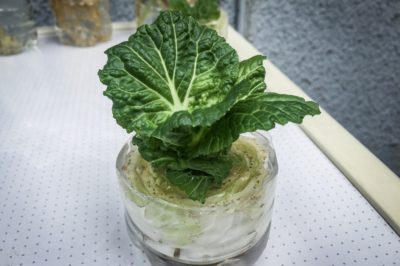In the Garden
The most common lettuces grown in the garden are looseleaf varieties. These are popular because they don’t require thinning and can be packed together. They are also called ‘cut-and-come-again’ greens because, as it sounds, they will regrow after being cut.
Loseleaf Lettuce
When looseleaf lettuce reaches 4-5 inches tall, cut the leaves with some scissors. Leave about an inch above the soil surface to avoid damaging the roots of the plants. That’s all there is to regrowing leaf lettuce, just cut and come again in a couple of weeks.
Butter Lettuce
Butter lettuces and other loosely heading varieties of lettuce will regrow from the central crown if it is left intact. Pick the outer leaves from these plants as harvest, but leave the center alone where new little leaves are forming. The plant will get taller and you pick, with new leaves popping out all the time.
Heading Lettuce
Heading lettuces like various Romaines can also regrow in the garden. You harvest the head by cutting it off of the stem. If you’re intentional about leaving some stem in the ground, you can regrow your Romaine. a 2-3 inch stem with undamaged roots is all you need. The plant will pump out new baby Romaine leaves within weeks. It will never form another nice head like the original harvest, but it will give enough for a salad.
In the Kitchen
Regrowing lettuce from scraps is a fun and educational project for kids and families. It’s easy to do and there’s really not many supplies necessary. Here’s what you’ll need:
- Lettuce Stem
- Shallow Container
- Sunny Windowsill
- Tap Water
First, don’t throw out that white stem that you’re left over with after eating a head of lettuce from the market or grocery store. Instead, turn it into a cool project and a new salad. Place the stem into a shallow container of water.
Make sure that the bottom is down and the top is up. If you can’t remember which way is up, look at the direction of the leaf nodes on the side of the stem, they typically point upward. Another indicator is the bottom of the stem that was cut long before the plant hit the supermarket shelves. That bottom will tend to be browned and hardened.
Place the stem into the container with enough water just to cover the base. If unsure, you can cover up to 50% of the stem, so place it half in the water and half out. Keep an eye on the water, it will need to be changed every couple of days. If it appears foggy or smells stagnant, refresh it.
Within a couple of days, you will start to see new leaves popping out of the stem’s top. You will also see roots starting to form at the base of the stem. Within a week or two, your plant will have sprung forth new leaves ready for eating. They will be just as delicious as the original leaves. Like the stems in the ground, it won’t head up again. It will continue to regrow leaves until it starts to move into a flowering stage.
Seed Saving
One other thing you can do with your regrown lettuce scraps is let them seed. Reproduce a favorite variety from the farmers market this way, or just watch the plant in all of its stages.
Repeat the above steps for regrowing from a stem scrap. When roots appear, put the plant in a pot with some soil and leave it in the window. The plant will leaf, and you can even eat these leaves. After a couple of weeks, it will send a central flowering shoot up from the crown. This shoot produces a cluster of purple, yellow, or white flowers depending on your variety.
These flowers will pollinate themselves, so there’s no need for bees or wind in order to get seed from them. After the flowers wilt, they will be replaced with fluffy parachutes similar to those on a dandelion seed head. Each parachute, called a pappus, will be attached to a few lettuce seeds. They are very small, but unmistakable as the cargo of the pappus.
Collect the seeds with your hands and plant them in the garden. Not only did this head of lettuce get eaten, but the stem produced more leaves and then more lettuce for next years garden.
